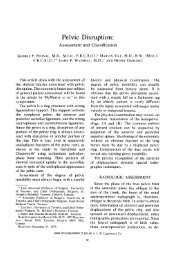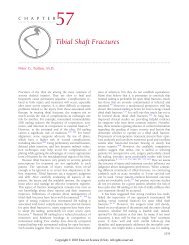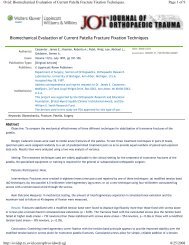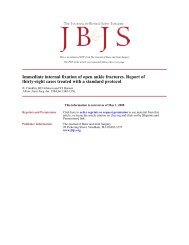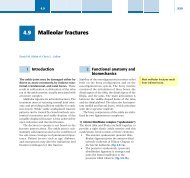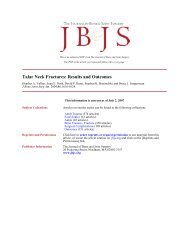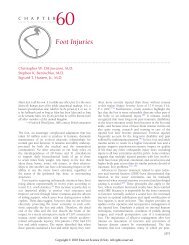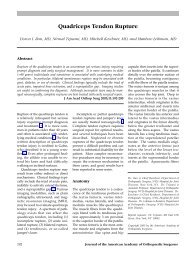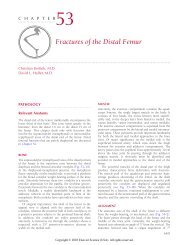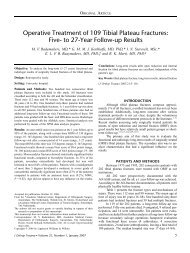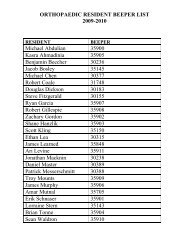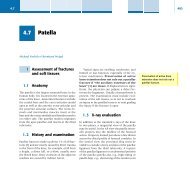Fixation with a Cannulated Screw Displaced Scaphoid Fractures ...
Fixation with a Cannulated Screw Displaced Scaphoid Fractures ...
Fixation with a Cannulated Screw Displaced Scaphoid Fractures ...
You also want an ePaper? Increase the reach of your titles
YUMPU automatically turns print PDFs into web optimized ePapers that Google loves.
DISPLACED SCAPHOID FRACTURES TREATED WITH OPEN REDUCTION AND INTERNAL FIXATION 639ated <strong>with</strong> slower healing at the 95 percent confidencelevel in both groups (p < 0.01). <strong>Fractures</strong> in patients whosmoked healed at an average of 5.2 months compared<strong>with</strong> 3.5 months in patients who did not smoke.Because the duration of follow-up was different ineach of the groups, a Kaplan-Meier 17 estimate was usedto evaluate the difference in the time to union betweenthe two screw types; there was no significant difference,<strong>with</strong> a power of 0.8. A shorter time to union was associated<strong>with</strong> greater grip strength and <strong>with</strong> a better rangeof motion of the wrist in both groups (p < 0.05). An increasein the time to union was correlated <strong>with</strong> increasingage of the patient (r = 0.665) and <strong>with</strong> increasingpreoperative displacement of the fracture (r = 0.541).The use of bone graft correlated <strong>with</strong> increasing time tounion (p < 0.05), which may represent preselection ofpatients <strong>with</strong> a more severe injury (<strong>with</strong> comminution),as all patients who received bone graft had comminutionnoted at the time of surgery. The time to union didnot correlate <strong>with</strong> the lateral intrascaphoid angle, anteroposteriorintrascaphoid angle, or height-to-lengthratio on preoperative radiographs. There was also nocorrelation between the time to union and gender orhand dominance.Postoperatively, the average total range of motionon the involved side was 86 ± 8 percent of that on thecontralateral side in Group 1; the patients had an averageof 120 ± 16 degrees of flexion-extension of the wristand 35 ± 10 degrees of radioulnar deviation. These resultsare similar to those in Group 2, in which the rangeof motion was 86 ± 7 percent of that on the contralateralside and the patients had an average of 113 ± 16 degreesof flexion-extension of the wrist and 35 ± 6 degrees ofradioulnar deviation. There was no significant differencein the range of motion between the two groups.Logistic regression analysis <strong>with</strong> adjustment for clinicaland radiographic variables showed that an increasingpostoperative range of motion correlated <strong>with</strong> a decreasinglateral intrascaphoid angle (r = 0.625) and a decreasingscaphoid height-to-length ratio (r = 0.584).Postoperatively, the patients in Group 1 regained an averageof thirty-eight kilograms of grip strength, or 80 ±11 percent of the strength on the contralateral side. Thepatients in Group 2 regained an average of forty-two kilogramsof grip strength, or 79 ± 16 percent of thestrength on the contralateral side. Twenty-eight patientswho were employed preoperatively returned to theirprevious occupation after the surgery.ComplicationsTwo of the patients treated <strong>with</strong> an AO/ASIF cannulatedscrew had symptoms related to a prominentscrew-head after union of the scaphoid. One patient ineach group had pain and irritation related to a prominentwire, requiring early removal of the wire. Only onepatient, in Group 1, had evidence of partial avascularnecrosis (stage 1) at the final follow-up examination.One patient in Group 1 and one in Group 2 had osteoarthritis(stage 1 in both) by the time of the final follow-upevaluation. None of the patients in either group hadsymptoms that limited their ability to work. Three patientsin Group 1 noted slight pain <strong>with</strong> strenuous activities(grade 1), as did two patients in Group 2. There wasno significant difference in terms of pain at work or duringstrenuous activity between the groups (p < 0.05).DiscussionMost reports regarding scaphoid fractures have focusedon nonunions. Herbert and Fisher 16 reported a 100percent rate of union following the treatment of 158acute displaced fractures of the waist of the scaphoid.We are not aware of any published reports that have includedpatients treated <strong>with</strong> cannulated screws. In thepresent retrospective study, we evaluated the results oftreatment <strong>with</strong> two different cannulated screws. We hadinitially used the cannulated AO/ASIF screw because itwas the first screw available on the market that met thedesign parameters needed to treat scaphoid fractures.Because of problems related to the prominent screwheadin some patients in a previous study 25 on the use of3.5-millimeter cannulated AO/ASIF screws for treatmentof scaphoid nonunion, we have subsequently preferredthe double-threaded Herbert-Whipple screw,which is a cannulated screw specifically designed for thetreatment of scaphoid fractures. Although Stark et al. 24noted an improvement in the scapholunate angle aftertreatment of scaphoid nonunion <strong>with</strong> Kirschner wiresand bone graft, we know of no reports of improvementin scaphoid alignment as assessed <strong>with</strong> measurement ofthe intrascaphoid angle or the scaphoid height-to-lengthratio after treatment of scaphoid fractures or nonunions<strong>with</strong> internal fixation devices.The rate of union in the present study was 100 percentfor both groups of patients. This success rate ismost likely attributable to our strict inclusion criteria,which enabled us to select an ideal group of patients. Weexcluded patients who had a fracture of the proximalpole, osteoarthritis, or carpal instability, all of whichhave been associated <strong>with</strong> a decreased rate of union 7,23 .Manske et al. 19 demonstrated that the use of a Kirschnerwire in addition to a screw controlled the rotation of thefracture fragments and improved both the time to unionand the rate of union after treatment of scaphoid nonunion.Therefore, we incorporated this technique intoour treatment of acute displaced scaphoid fractureswhen comminution was present.Because it is difficult to design a comparative studyin which the number of patients is large enough for therate of union to be used as the end point, we studied thetime to union as confirmed by computerized tomography.The importance of using tomography for thispurpose was demonstrated by Cooney et al. 8 , who foundthat patients managed <strong>with</strong> screw fixation who werethought to have a healed nonunion on the basis of plainVOL. 82-A, NO. 5, MAY 2000



